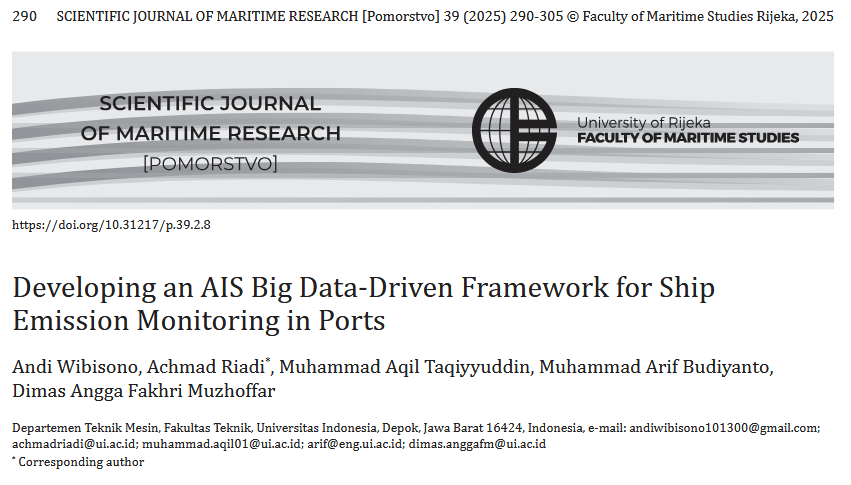Developing an AIS Big Data-Driven Framework for Ship Emission Monitoring in Ports
Keywords:
Ship emission, Emission monitoring, Tanjung Priok Port, Automatic Identification System (AIS), Big data, Maritime transportationAbstract
The rapid expansion of maritime transportation has significantly impacted air quality due to increased ship emissions. This study aims to develop a ship emission monitoring system utilizing Automatic Identification System (AIS) big data, with Tanjung Priok Port in Indonesia (ID TPP) as the case study. The system is designed to monitor and analyze ship emissions based on historical AIS data, providing actionable insights to mitigate environmental impacts. By integrating various data processing techniques, including data preprocessing, database development, sailing time and speed calculation, and emission estimation, this research provides a comprehensive framework for a ship emission monitoring system. The system can be implemented in ports through the development of an interactive web-based dashboard, enhancing the decision-making capabilities of port authorities and other stakeholders. The results demonstrate the system’s potential for effectively monitoring emissions and promoting sustainable maritime operations .

Downloads
Published
Issue
Section
Categories
License
Copyright (c) 2025 Andi Wibisono, Achmad Riadi, Muhammad Taqiyyuddin, Muhammad Budiyanto, Dimas Muzhoffar

This work is licensed under a Creative Commons Attribution-NonCommercial-NoDerivatives 4.0 International License.
Scientific Journal of Maritime Research understands the need for authors to disseminate and maximize the impact of their research. When submitting an article for publishing in Scientific Journal of Maritime Research, it implies that the Corresponding Author transfers, with the consent of all Coauthors, the copyright ownership in the referenced submission, including all versions in any format now known or hereafter developed, to the Scientific Journal of Maritime Research.
Copyright protects your original work and research material and prevents others from using it without your permission. Others will be required to credit you and your work properly, thus increasing its impact. Should your submission be rejected or withdrawn prior to acceptance for publication by Scientific Journal of Maritime Research, this transfer will be null and void.
Authors, users or readers of an article need clear instructions on how they can use the article. Scientific Journal of Maritime Research uses the Creative Commons Attribution-NonCommercial-NoDerivatives (CC-BY-NC-ND) 4.0 International License, which governs the use, publishing and distribution of articles by authors, publishers and the wider general public.
The authors are allowed to post a digital file of the published article, or the link to the published article (Scientific Journal of Maritime Research web page) may be made publicly available on websites or repositories, such as the Author’s personal website, preprint servers, university networks or primary employer’s institutional websites, third party institutional or subject-based repositories, and conference websites that feature presentations by the Author(s) based on the published article, under the condition that the article is posted in its unaltered Scientific Journal of Maritime Research form, exclusively for non-commercial purposes.




